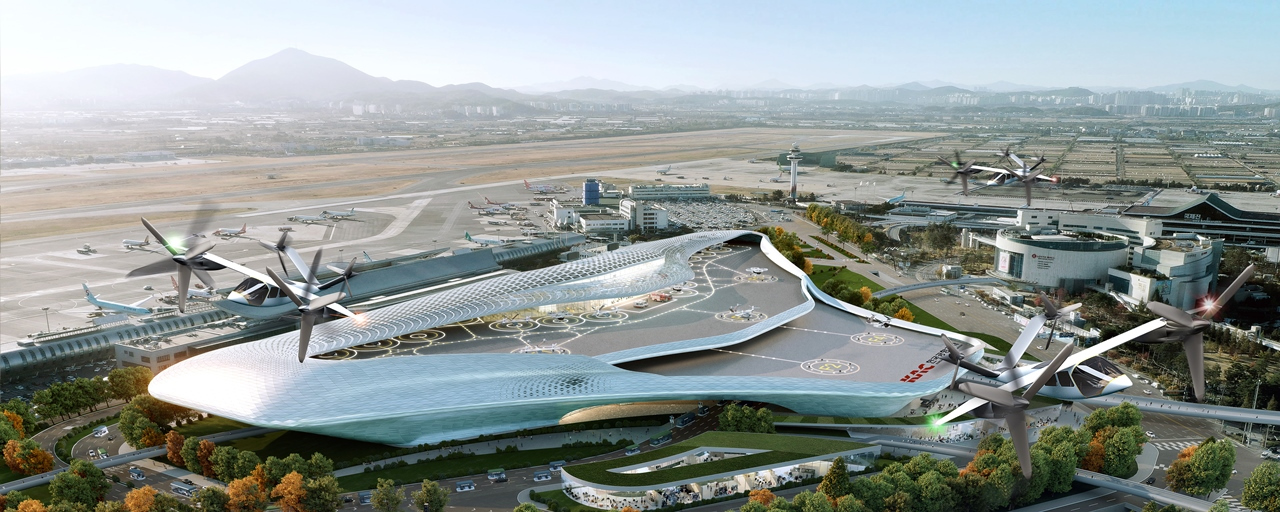Four-way partnership forged for flying cars
‘Dream team’ of KAC, Hanwha, SKT and KOTI to accelerate efforts to commercialize air taxis
By Yim Hyun-suPublished : Jan. 28, 2021 - 15:01

Korea Airports Corp., Hanwha Systems, SK Telecom and the Korea Transport Institute have formed a four-way partnership to accelerate the commercialization of flying cars, or urban air mobility vehicles.
Leaders from each party signed a memorandum of understanding at KAC’s headquarters in western Seoul on Wednesday as part of efforts to form a “dream team” with the goal of trialing commercial air taxis by 2025, the corporation announced on Thursday.
The move will see KAC build and operate vertiports for UAM vehicles and focus on traffic control while Hanwha Systems will be in charge of developing UAM vehicles as well as navigation, control and ICT solutions.
SK Telecom will create a mobility platform and a next-generation communication network model for air transportation.
“To safely control urban air mobility, a stable telecom infrastructure that connects vehicles and ground control [will be built,]” the telecoms network explained.
The company said it will also develop a mobility platform that provides additional traffic information such as transfers between UAM vehicles and buses, trains or personal transporters such as electric kick scooters.
KOTI will take on the role of predicting demand for UAM services and how well they will be accepted by the public.
The new MOU is the latest in a series of South Korea’s efforts to take lead in urban air mobility, which is likely to give a boost to its plans to trial the commercialization of air taxis in the next four years.
The first-generation flying cars will be human-driven and fly at a speed of 150 kilometers per hour with a maximum travel distance of 100 kilometers between 2025 and 2030. From 2035, all vehicles will be self-driving and be able to travel 300 kilometers in an hour.
In November, the Seoul Metropolitan Government co-hosted an event with the Transport Ministry during which it flew a drone taxi over the financial district of Yeouido, western Seoul, for the first time.
“The introduction of the new transportation system will dramatically reduce travel time. It will take passengers less than 20 minutes to go from Yeouido to Incheon International Airport,” said Vice Minister Son Myung-soo at the event.
The world’s UAM industry will be worth 731 trillion won ($655 billion) by 2040, according to the transport ministry estimate.
“The new partnership will be a turning point for South Korea to become a global leader in the UAM market. With the combined ability of the four entities, we will take a lead in making sure that the public can enjoy the new means of air transport that is UAM in 2025,” said KAC president Son Chang-wan.
Kim Youn-chul, the CEO of Hanwha Systems, also pledged to seek business opportunities in partnership with leading companies in the future mobility industry.
By Yim Hyun-su (hyunsu@heraldcorp.com)
Leaders from each party signed a memorandum of understanding at KAC’s headquarters in western Seoul on Wednesday as part of efforts to form a “dream team” with the goal of trialing commercial air taxis by 2025, the corporation announced on Thursday.
The move will see KAC build and operate vertiports for UAM vehicles and focus on traffic control while Hanwha Systems will be in charge of developing UAM vehicles as well as navigation, control and ICT solutions.
SK Telecom will create a mobility platform and a next-generation communication network model for air transportation.
“To safely control urban air mobility, a stable telecom infrastructure that connects vehicles and ground control [will be built,]” the telecoms network explained.
The company said it will also develop a mobility platform that provides additional traffic information such as transfers between UAM vehicles and buses, trains or personal transporters such as electric kick scooters.
KOTI will take on the role of predicting demand for UAM services and how well they will be accepted by the public.
The new MOU is the latest in a series of South Korea’s efforts to take lead in urban air mobility, which is likely to give a boost to its plans to trial the commercialization of air taxis in the next four years.
The first-generation flying cars will be human-driven and fly at a speed of 150 kilometers per hour with a maximum travel distance of 100 kilometers between 2025 and 2030. From 2035, all vehicles will be self-driving and be able to travel 300 kilometers in an hour.
In November, the Seoul Metropolitan Government co-hosted an event with the Transport Ministry during which it flew a drone taxi over the financial district of Yeouido, western Seoul, for the first time.
“The introduction of the new transportation system will dramatically reduce travel time. It will take passengers less than 20 minutes to go from Yeouido to Incheon International Airport,” said Vice Minister Son Myung-soo at the event.
The world’s UAM industry will be worth 731 trillion won ($655 billion) by 2040, according to the transport ministry estimate.
“The new partnership will be a turning point for South Korea to become a global leader in the UAM market. With the combined ability of the four entities, we will take a lead in making sure that the public can enjoy the new means of air transport that is UAM in 2025,” said KAC president Son Chang-wan.
Kim Youn-chul, the CEO of Hanwha Systems, also pledged to seek business opportunities in partnership with leading companies in the future mobility industry.
By Yim Hyun-su (hyunsu@heraldcorp.com)







![[KH Explains] How should Korea adjust its trade defenses against Chinese EVs?](http://res.heraldm.com/phpwas/restmb_idxmake.php?idx=644&simg=/content/image/2024/04/15/20240415050562_0.jpg&u=20240415144419)










![[Today’s K-pop] Stray Kids to return soon: report](http://res.heraldm.com/phpwas/restmb_idxmake.php?idx=642&simg=/content/image/2024/04/16/20240416050713_0.jpg&u=)